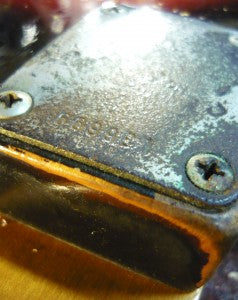1964 Fender Jazzmaster
Share
I seem to be getting a lot of "offsets" in recently which is fine by me as they're pretty much my favorite Fenders, and by favorite I mean the only Fenders I actually like...........
This one came in from an old friend who I don't see much who is playing some shows with his old band soon and wanted to use his old gear so he took this out after being in storage for years and it was almost unplayable.
Although it had been stored in it's (original Stanford) hardcase there had been slight moisture that caused some mold and everything had shifted slightly so it needed a good set up and a bit of TLC.


The electrics worked but were very scratchy but I was keen to not replace too much of the guitar if I could help it. It's mostly original and apart from great player wear (real relic) it is in good condition.
I took the scratch plate off which, like all of these period Fenders had shrunk considerably. You've got to be pretty careful taking these off as you can quite easily break parts like pickup covers or the scratch plate itself if you try and force it.


With the scratch plate off it was obvious that the electrics hadn't been touched. It's a lovely touch to see these old Fenders cloth wire hand wrapped in tape from the factory to make assembly easier.
This original pot dates from 21st week 1964 and the rest of the electrics are pretty much intact also.
A good clean up and everything was as it should be. Now, those frets .......................


The frets were very worn and it probably needed a re-fret but he wasn't going to play it a lot so I figured I'd see if I could get it playing nicely with the original frets as it would save him money and also keep the guitar original and playable.
I gave them a delicate dress and then worked on a few troublesome frets and got it to the point I was pretty happy with the fret level and crowns. I thought I'd put a bit more work in and see what it played like when I got it back together.





With the frets polished and looking good it was time to put the neck back on and do a set up. I've said it before and I'll say it again as it's a VERY common point for a repairer to hear. Any well set up Jazzmaster will work perfectly fine with the original Jazzmaster bridge on it. While I have no problem with aftermarket bridges and "hold down" gadgets that promise to "fix" your Jazzmasters bridge problems, I do think they are just selling to a fear players have about this system.
A well set up Jazzmaster (and Jaguar) will have NO PROBLEMS with an original design bridge. If you don't have time, money or access to a good repairer then a Mustang bridge or aftermarket bridge will also work in most cases, but it's not essential to a well playing and sounding Jazzmaster.





As you can see the scratch plate had shrunk to the point where the pick ups wouldn't fit back in the holes in the plate. I carefully filed out some room so as not to further damage the pick up covers and/or the scratch plate.
With everything back together and the guitar set up it is an absolute dream to play. Action is great and the intonation is perfect and it has amazing sustain.
If your tech tells you to buy an expensive replacement bridge to get your offset set up properly, take it somewhere else. It takes time and skill, but the original bridge works extremely well when done properly. I use them on my Jazzmasters.













